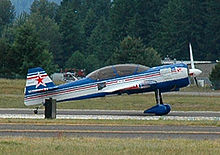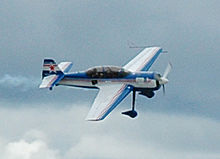Sukhoi Su-29
| Su-29 | |
|---|---|
 A Su-29 at Kubinka Air Base | |
| General information | |
| Type | Aerobatic aircraft Military trainer[1][2] |
| National origin | Russia |
| Manufacturer | Sukhoi |
| Status | Active |
| History | |
| First flight | 1991 |
| Developed from | Sukhoi Su-26 |
| Developed into | Sukhoi Su-31 |


The Sukhoi Su-29 is a Russian two-seat aerobatic aircraft with a 268 kW (360 hp) radial engine. It was designed based on the Su-26 and inherited most of the design and technical features of its predecessor. Due to wide use of composite materials, which make up as much as 60% of the Su-29's aircraft structure, the empty weight is increased by only 50 kg (110 lb) over the single-seat Su-26's empty weight.
The Su-29 is used for initial pilot aerobatics education, flight training, and participation of pilots in aerobatics competitions and air shows, as well as for maintaining flight skills of military and civil pilots.
Operators
[edit]- Argentine Air Force ordered eight Su-29ARs to equip the Cruz del Sur (Southern Cross) aerobatic team.[3]
Specifications (Su-29)
[edit]Data from Jane's All The World's Aircraft 1993–94,[5] Sukhoi[6]
General characteristics
- Crew: 2
- Length: 7.29 m (23 ft 11 in)
- Wingspan: 8.2 m (26 ft 11 in)
- Height: 2.87 m (9 ft 5 in)
- Wing area: 12.24 m2 (131.8 sq ft)
- Airfoil: root: Symmetrical 18% ; tip: Symmetrical 12%[7]
- Empty weight: 760 kg (1,676 lb)
- Max takeoff weight: 1,100 kg (2,425 lb)
- Powerplant: 1 × Vedeneyev M14P 9-cylinder air-cooled radial piston engine, 265 kW (355 hp)
- Propellers: 3-bladed, 2.4 m (7 ft 10 in) diameter
Performance
- Maximum speed: 340 km/h (210 mph, 180 kn)
- Cruise speed: 295 km/h (183 mph, 159 kn)
- Stall speed: 110 km/h (68 mph, 59 kn)
- Ferry range: 965 km (600 mi, 521 nmi)
- Service ceiling: 4,000 m (13,000 ft)
- g limits: +12
- Roll rate: >360°/s
- Rate of climb: 18 m/s (3,500 ft/min)
See also
[edit]Related development
Aircraft of comparable role, configuration, and era
References
[edit]- ^ "Russia Rethinks Trainer Options | Defense News: Aviation International News". 2022-12-18. Archived from the original on 2022-12-18. Retrieved 2023-08-20.
- ^ "Sukhoi Su-29 | The Flying Bulls". 2022-11-29. Archived from the original on 2022-11-29. Retrieved 2023-08-20.
- ^ Sap 2002, pp. 78–79.
- ^ "Aircraft – ITPS Canada". Retrieved 2020-10-09.
- ^ Lambert 1993, p.315.
- ^ Su-26, 29, 31 Specifications
- ^ Lednicer, David. "The Incomplete Guide to Airfoil Usage". m-selig.ae.illinois.edu. Retrieved 16 April 2019.
Further reading
[edit]- Taylor, Michael J.H.; Lambert, Mark; Munson, Kenneth, eds. (1993). Jane's all the World's Aircraft 1993–94 (84th ed.). Coulson, Surrey, UK: Jane's Information Group. p. 315. ISBN 978-0710610669.
- Sap, Marnix (2002). "Groupo Aéreo de Caza: Argentina's fighter school". International Air Power Review. 3 (Winter 2001/2002): 76–79. ISSN 1473-9917.
External links
[edit]![]() Media related to Sukhoi Su-29 at Wikimedia Commons
Media related to Sukhoi Su-29 at Wikimedia Commons
